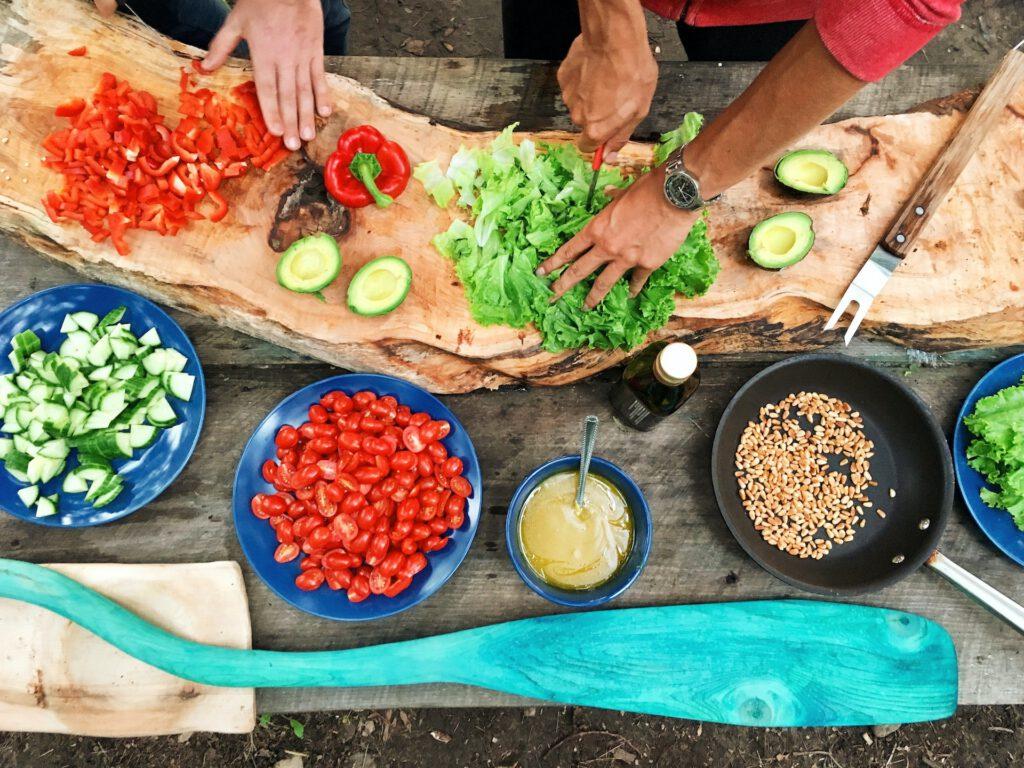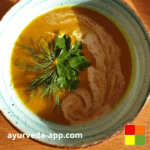Ayurveda Cooking

Ayurveda cooking is the practice of using food, spices, and herbs as medicine to nourish and balance the body. The goal of Ayurvedic cooking is to support each individual’s unique constitution by incorporating specific foods and spices into their diet. It emphasizes the use of fresh, whole foods, and encourages the consumption of local and seasonal food. By following these principles, Ayurveda cooking promotes digestion, boosts immunity, and improves overall health and well-being
Check out all our Ayurvedic recipes.
General questions about Ayurvedic nutrition
- What is Ayurvedic Diet?
Ayurvedic nutrition recommends eating individually according to your dosha type and to orientate yourself on the times of the day. In addition, prefere seasonal and fresh foods such as fruit and vegetables, and eating 3 regular meals a day. - What do you eat in the evening in Ayurveda?
In the evening it is better to eat warm but light. Because now the Agni (digestive fire) is rather weak and cannot digest as well as, for example, at noon (pitta time). - Is Ayurvedic Diet Meatless?
Many recipes in Ayurveda cooking are often vegetarian and even vegan. Although meat and dairy products are present from time to time, these are primarily classified as heavy foods and vegetables and legumes have priority.
Simple & quick Ayurveda cooking recipes
According to Ayurveda, how do you eat? Here you will find super easy and quick Ayurvedic recipes for your everyday life! You will also learn exactly why the times of day are so important in Ayurveda and why you should adjust your meals accordingly.
Why the daily cycle is so important according to Ayurveda
The Ayurvedic diet is easier than many people think, and above all holistic. Because the Ayurvedic philosophy assumes that as the seasons change, people should also adjust to them. It goes without saying that nutrition is the top priority.
The three bioenergies Vata, Pitta, and Kapha are assigned to the seasons and the daily cycle. The saying “Eat like a king in the morning, like a king at lunchtime, and at night like a pauper” doesn’t quite apply here. Instead, Ayurveda recommend the following:
Examples of simple & quick Ayurvedic cooking recipes
The focus of Ayurvedic recipes is less raw food, but warm and cooked or steamed food so that it is digestible
Eat 3 regular meals and to avoid snacks so that your Agni can digest everything well.
The Agni is at its greatest at midday and can therefore absorb and digest raw food and the like much better.
Don’t forget to drink, but preferably between meals.
So it’s not that complicated to eat healthy and delicious and integrate Ayurvedic recipes into your daily life. The main thing is to listen to your body and try to eat a balanced diet.
The balance of the doshas is the ultimate goal in Ayurvedic philosophy and at the same time the key to our health and well-being! Have fun with the recipes and bon appetit!
Ayurvedic recipes take the times of the day into account. Morning is Kapha time and this Dosha type generally has a rather sluggish digestion. The metabolism is still tired and the body has to get going first. Therefore, something warm but easily digestible is suitable for breakfast.
Breakfast
Date and oat porridge,
start your day warm and happy.
What’s better than a sweet, warm porridge to start the day perfectly? This recipe is super quick to make and guaranteed to taste great and be filling.

In Ayurveda, snacks are usually avoided and three well-balanced warm meals are recommended. But if you also like to eat salads and raw vegetables (especially well tolerated by Pitta types), according to Ayurveda cooking this should be eaten at lunchtime. Because now is the time of the Pitta dosha!
At lunchtime, you should have the main meal. Because Pitta is fiery, the digestive fire (Agni) is now at its greatest and hunger is usually too!
Lunch:
Bean salad with quinoa and zucchini,
high in protein and healthy.
This recipe is great for a power lunch since it’s rich in protein and dietary fibre.

This recipe is great for Pittas in particular, but Vata and Kapha types also benefit from a serving of protein and dietary fibre at lunchtime. In general, types with a sluggish digestive fire, such as Vata or Kapha types, can eat a portion of raw food for lunch. In the evening, on the other hand, eat cooked and warm food so that the Agni is not overwhelmed.
Dinner:
Sweet Potato Coconut Soup
eat you beautiful and happy
It can be warm again for dinner. With this recipe, you not only balance your doshas but also nourish your body from within. The perfect dinner for a good night’s sleep!

It is also important not to eat your last meal too late so as not to disturb your sleep. Because around 10:00 p.m. to 2:00 a.m. the second Pitta period is dominant again and is responsible for carrying out important regeneration work in the body. It is therefore not advisable to go to bed later than 10 p.m.
Last, you can find more recipes on our Recipes blog.
Ayurveda breakfast
Ayurveda is a traditional Indian system of medicine that emphasizes the importance of maintaining a healthy balance between the body, mind, and spirit. Thus, this system recommends a balanced and nourishing diet to promote good health and well-being. Furthermore, here are some ideas for cooking an breakfast from Ayurveda:
- Warm water with lemon: Start your day with a glass of warm water with the juice of half a lemon. This helps to kickstart your metabolism and aids digestion.
- Kitchari: Kitchari is a traditional Ayurvedic dish made with rice, lentils, and spices. It is a complete protein and is easily digestible. You can add vegetables of your choice to make it more nourishing. For the main dish you can choose the European version of kitchari
- Fresh fruits: Eating fresh fruits is an excellent way to start your day. Fruits are rich in essential vitamins, minerals, and dietary fibre that nourish your body.
- Herbal tea: Herbal tea is a great way to boost your energy levels and aid digestion. You can choose from a wide range of herbal teas such as ginger, tulsi, or chamomile.
- Idli: Idli is a traditional South Indian breakfast dish made with fermented rice and lentil batter. It is easy to digest, and the fermentation process makes it rich in probiotics.
- Oatmeal: Oatmeal is a healthy and nourishing breakfast option. You can add nuts, seeds, and fruits to make it more filling and nutritious.
Remember, an Ayurvedic breakfast should be nourishing and easy to digest. It should also be eaten in a calm and peaceful environment to aid digestion and promote mental clarity.
Ayurvedic appetizer
Ayurveda recommends a balanced and nourishing diet to promote good health and well-being. Here are some ideas for cooking an appetizer from Ayurveda:
- Spiced nuts: You can roast some nuts like almonds, cashews, or walnuts in ghee or coconut oil and sprinkle them with spices like cumin, coriander, and black pepper.
- Vegetable samosas: Samosas are a popular Indian snack made with spiced vegetables, wrapped in a pastry dough and fried. You can use vegetables like potatoes, peas, and carrots, and season them with cumin, coriander, and turmeric.
- Lentil soup: Lentil soup is a warming and nourishing appetizer that is easy to digest. You can use split yellow or red lentils and season them with cumin, coriander, and ginger.
- Roasted vegetables: Roasted vegetables like sweet potatoes, beets, and carrots are a tasty and healthy appetizer. You can sprinkle them with spices like cumin, coriander, and turmeric.
- Hummus: Hummus is a popular Middle Eastern dip made with chickpeas, tahini, lemon juice, and garlic. You can add some cumin or coriander to give it an Ayurvedic twist. Try our recipe for curry hummus, pink hummus and white beans hummus for delicious ayurvedic versions.
Remember, an Ayurvedic appetizer should be easy to digest and use fresh, whole ingredients. It should also be eaten in a calm and peaceful environment to aid digestion and promote mental clarity.
Main dishes
Ayurveda recommends a balanced and nourishing diet to promote good health and well-being. Here are some ideas for cooking Ayurvedic main disheTs:
- Kitchari: Kitchari is a traditional Ayurvedic dish made with rice, lentils, and spices. It is a complete protein and is easily digestible. You can add vegetables of your choice to make it more nourishing.
- Vegetable curry: A vegetable curry made with fresh vegetables like cauliflower, carrots, potatoes, and spinach is a delicious and healthy Ayurvedic main dish. You can use spices like cumin, coriander, and turmeric to enhance the flavor.
- Quinoa salad: A quinoa salad made with fresh vegetables and herbs like cucumber, tomatoes, parsley, and mint is a nourishing and satisfying Ayurvedic main dish.
- Lentil dal: Lentil dal is a warming and nourishing dish made with split lentils and spices like cumin, coriander, and turmeric. You can serve it with rice or flatbread.
- Baked sweet potato: A baked sweet potato is a simple yet satisfying Ayurvedic main dish. You can top it with ghee, spices, and fresh herbs like cilantro.
Last, remember that Ayurvedic main dishes should be easy to digest, use fresh, whole ingredients, and be well-balanced. You should also eat in a calm and peaceful environment to aid digestion and promote mental clarity.
Browse the compendium:
0. Ayurvedic Expert Consultation
0.1. Ayurvedic Treatments
1. About Ayurveda
2. Healthy Life
3. Beauty and Ayurveda
4. Weight Balance
5. Ayurvedic Medicines
6. Stress Balance
7. Ayurveda Cooking
7.1. Ayurveda Recipes
8. Diabetes and Ayurveda
9. Yoga, Meditation and Pranayama
10. Ayurveda Approach for Diseases
